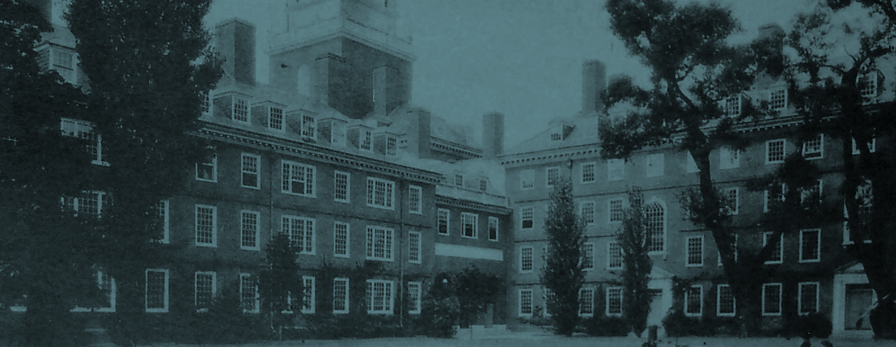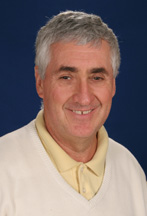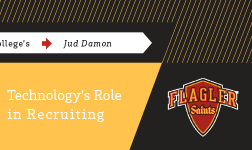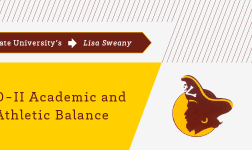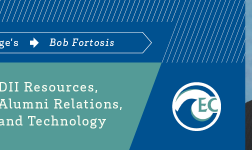Athletic Director
South Dakota School of Mines & Technology
Dr. Dick Kaiser has served as Athletic Director at the South Dakota School of Mines & Technology since 2009, and has overseen SDSM&T’s transition from the NAIA to NCAA Division II Athletics. Dr. Kaiser was good enough to offer some thoughts on this transition, as well as advice for new and hopeful ADs.
What is one challenge that your program has overcome and one future challenge you see you’d like to surmount?
One significant challenge our institution has overcome is preparing and being accepted into the NCAA D-II membership process. It took close to a year to prepare the application and it is quite a step to move from NAIA to NCAA D-II. It takes a significant commitment on the part of the administration, boosters and student-athletes because there definitely will be some dark times during the 3 year process.
To get everyone to buy into the move and be supportive was definitely a big step for our university. As for the future challenge, actually there are two. The first would be that we successfully complete the NCAA D-II membership process by completing all the final hurdles and that we are accepted as a full member sometime in summer, 2013. This would culminate a four year dedication by many, many people within and outside the university to this goal.
The second challenge is to find a conference for all our teams. Currently we are the only NCAA D-II independent west of the Mississippi River. That makes scheduling very, very difficult. We got caught in a numbers game with some conferences we thought were interested in us and invited us to apply and now we are the lone wolf. It has been very challenging to get games as the D-II Regions where we have been assigned are going to all-conference scheduling in some sports and limited open dates in others.
Some of the regional D-II teams have been willing to play us and that has been appreciated, but many others will attempt to fit us in only if we travel to their site and they usually won’t return the date. Thus we have teams traveling 900 to 1200 miles to just get a game. That’s not a good thing when your institution specializes in math, science, engineering and research.
Our student-athletes are having to miss too many days of class at the present time so if we could get invited to a conference, that would really help.
What aspect of your tenure at South Dakota School of Mines and Technology are you most proud of?
That’s an interesting question, as there have been many high points in my four years here, but they have been a combined effort by everyone on the staff. Personally I have accomplished nothing singularly, but as a staff we have made tremendous progress.
I would say a couple of the high points are that we have increased our scholarship dollars by nearly 50%. That was huge considering the State of South Dakota requires all athletic and academic scholarship dollars to be fund raised outside of the university, as no institutional financial support for scholarship assistance can be used.
Second, through fund raising and institutional support, we have significantly enhanced our operational dollars which became a necessity as we moved the membership process forward. These increases have shown a significant amount of support and buy-in on the part of the campus administration, and that has played a huge role in what successes we have had during the process.
Third, I would say we have made some significant progress in the overall staffing situation. We have been able to move several part-time coaching positions to full-time. We have added a couple of non-required but very needed administrative staff members to help us accomplish this membership process and we have added support personnel in areas like athletic training and equipment where we were woefully short.
Fourth, one of our biggest accomplishments has been to grow the number and quality of student-athletes from just under 200 to over 300 since 2010. This has been achieved by placing a high emphasis on recruiting D-II student-athletes and significantly increasing our recruiting funds so that our coaches could recruit from larger metropolitan areas instead of just regionally. And finally, it was a great accomplishment to add the first men’s new sport (soccer) in over 45 years at the university.
What has most surprised you during your tenure at SDSM&T?
Again, that is another interesting question. I think I have two areas that have most surprised me. First, I would have to say the length of time it has taken to get some of our boosters, supporters and even some of our coaches on board with the move from NAIA to NCAA. Many of our sports had good success and a long tradition at the NAIA level as SDSM&T had been a member for over 50 years. They didn’t understand or really have any desire, nor see the need to move the University into a “more difficult’” sports arena like D-II. It has taken quite a bit of time to convince these individuals the move was what was best for the university, not just athletics.
Recently deceased SDSM&T President Robert Wharton was a strong advocate of “continuous quality improvement” and being a “world class institution” and we needed to have the athletics program emulate the academic status of the University, if we were to fulfill his ultimate goal. The second surprising thing has been the difficulty for SDSM&T to gain conference affiliation.
At the start of the membership process I was probably naïve to think that because we were this quality academic institution with high-achieving students, that we would be a real catch for some conference and that we would surely get an invitation. Obviously that has not been the case and because of our geographic location it has become very difficult. I mistakenly thought the NCAA would assist in the process once we hit the snag but have come to find out conference membership is up to the conference members.
All we can do is continue to make ourselves a viable candidate and hopefully someone will decide we would be good members. There’s really nothing else I can do.
What’s your best advice for a new or hopeful AD?
I got my first taste of athletic administration during my first position just out of college at age 22. I was the athletic director, head football, head basketball, head baseball coach, and taught all the physical education classes at a very small high school in Colorado. My first full-time collegiate Athletic Director position occurred at age 32 and I was definitely in over my head, but I must have done something right because I’ve been a collegiate AD now for 30 years.
Why I provide this information is because I think my first piece of advice would be that no administrative job is “too small” and try to get as many hands-on opportunities, as early and as quickly, as you can. Every time an individual gets the opportunity to take on administrative duties, they need to jump on it with both feet.
There was one position in my career where I was a college football coordinator, teacher of 3-4 classes, part-time athletic trainer, head tennis coach, department chairperson and the athletic director all at the same time. Was it difficult? Absolutely, but it provided immeasurable experiences in dealing with people, time management and learning to delegate.
Not every college is located in the prime geographic locations and cities of the world but if you want to learn the business, then don’t shy away from looking at opportunities in possibly remote locations. I would say another potential key to success is to get as much training and education as you can. I was the front seven primary football assistant for a Division I NCAA program while I was working on my doctorate, which meant taking classes at night and in the summer.
I’ll never forget getting up at 4:30 AM to drive 250 miles to take my orals for my doctorate, being in front of the review panel for close to two hours, and then getting back in the car to return home so that I could coach the defense that night versuses a quality D-I opponent in a huge game (which we won by the way). The earning of my doctorate has been like a Willy Wonka moment for me, as it has been a primary reason why I have gotten some jobs over other qualified candidates.
Another key, a new administrator can’t be afraid to get their hands dirty and to do the grunt work. I can’t tell you how many times I have mowed athletic fields, raked baseball-softball fields, done the laundry for teams and other various trivial but important tasks. You do what you need to do to get the job done and as a first time athletic administrators you must be willing to say “can I help you?” Then after the job is done, a first time administrator must learn early to take none of the credit. It needs to always be about the success of the staff and not the administrator.
And lastly, if I could give any specific advice to new administrators it would be that “you won’t be one of the guys or gals anymore”. You will be looked at in a different light and may not get the invitations to lunch or to go get a “cold one” like you did before. That may be difficult for some because they want to be liked by all, but to be a leader you sometimes have to go against the grain and do what’s right for the program and not necessarily what’s right for the individual.
How has technology impacted the planning and the execution of goals for SDSM&T?
Technology has obviously significantly increased our opportunities to communicate. Whether it be with staff, student-athletes or boosters, the available technology in today’s world has made constant communication a necessary part of the job. We can do live video chats with potential boosters and we can keep people up-to-date with live stats just through the available technology.
As administrators, we absolutely have no excuses for not keeping everyone in the know and on the same page. The technological advances have also obviously made our jobs more difficult, more complex, but also more exciting. We have an obligation to use as much of the new technology as possible to promote our programs. We no longer are merely the budget managers and game administrators, new technology has created a whole new dynamic to being a collegiate athletic administrator.
The expectations of the public continue to grow and grow and it is our jobs now to try to “feed the monster” that we have created. Game experiences, tailgating, multi-purpose scoreboards and off-site video streaming (to name just a few) have brought the world of intercollegiate athletics available to everyone.
We, as athletic administrators, are expected to fully use the available technological resources that are being created to enhance our programs and the experience of our fans. The use of technology has definitely assisted SDSM&T in executing and achieving our goals but it also created a whole new level of “immediate” demands that we often struggle to achieve.
Obviously there is no turning back, therefore we have to figure out ways to use what technology we can adapt and afford to our purposes and use them to the best of our ability and manpower to get the word out concerning our intercollegiate athletic program.

